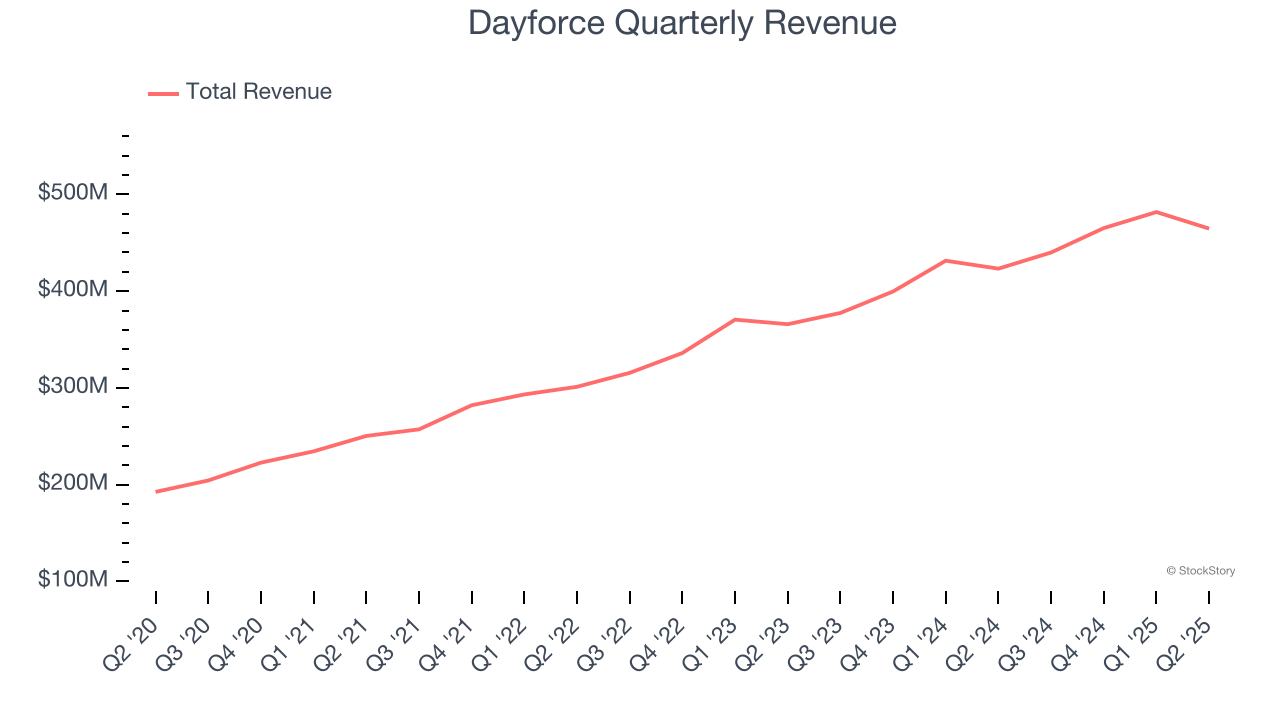
Online payroll and human resource software provider Dayforce (NYSE:DAY) reported Q2 CY2025 results beating Wall Street’s revenue expectations, with sales up 9.8% year on year to $464.7 million. On the other hand, next quarter’s revenue guidance of $439 million was less impressive, coming in 9.2% below analysts’ estimates. Its non-GAAP profit of $0.61 per share was 16.1% above analysts’ consensus estimates.
Is now the time to buy Dayforce? Find out by accessing our full research report, it’s free.
Dayforce (DAY) Q2 CY2025 Highlights:
- Revenue: $464.7 million vs analyst estimates of $457.7 million (9.8% year-on-year growth, 1.5% beat)
- Adjusted EPS: $0.61 vs analyst estimates of $0.53 (16.1% beat)
- Adjusted EBITDA: $147.2 million vs analyst estimates of $141.4 million (31.7% margin, 4.1% beat)
- The company slightly lifted its revenue guidance for the full year to $1.76 billion at the midpoint from $1.76 billion
- Operating Margin: 9.1%, up from 3.3% in the same quarter last year
- Free Cash Flow Margin: 18.7%, up from 4% in the previous quarter
- Market Capitalization: $8.51 billion
“Dayforce’s momentum remained strong through the second quarter, with year-to-date bookings growing over 40% year-over-year,” said David Ossip, Chair and CEO of Dayforce.
Company Overview
Founded in 1992 as Ceridian, an outsourced payroll processor and transformed after the 2012 acquisition of Dayforce, Dayforce (NYSE:DAY) is a provider of cloud based payroll and HR software targeted at mid-sized businesses.
Revenue Growth
A company’s long-term sales performance is one signal of its overall quality. Even a bad business can shine for one or two quarters, but a top-tier one grows for years. Over the last three years, Dayforce grew its sales at a 17.8% annual rate. Although this growth is acceptable on an absolute basis, it fell slightly short of our standards for the software sector, which enjoys a number of secular tailwinds.

This quarter, Dayforce reported year-on-year revenue growth of 9.8%, and its $464.7 million of revenue exceeded Wall Street’s estimates by 1.5%. Company management is currently guiding for flat sales next quarter.
Looking further ahead, sell-side analysts expect revenue to grow 10.5% over the next 12 months, a deceleration versus the last three years. Still, this projection is above the sector average and implies the market is baking in some success for its newer products and services.
Today’s young investors won’t have read the timeless lessons in Gorilla Game: Picking Winners In High Technology because it was written more than 20 years ago when Microsoft and Apple were first establishing their supremacy. But if we apply the same principles, then enterprise software stocks leveraging their own generative AI capabilities may well be the Gorillas of the future. So, in that spirit, we are excited to present our Special Free Report on a profitable, fast-growing enterprise software stock that is already riding the automation wave and looking to catch the generative AI next.
Customer Acquisition Efficiency
The customer acquisition cost (CAC) payback period measures the months a company needs to recoup the money spent on acquiring a new customer. This metric helps assess how quickly a business can break even on its sales and marketing investments.
Dayforce is extremely efficient at acquiring new customers, and its CAC payback period checked in at 14.8 months this quarter. The company’s rapid recovery of its customer acquisition costs means it can attempt to spur growth by increasing its sales and marketing investments.
Key Takeaways from Dayforce’s Q2 Results
We enjoyed seeing Dayforce beat analysts’ revenue and EPS expectations this quarter as operating margin stepped up meaningfully year on year. On the other hand, its full-year revenue guidance missed and its revenue guidance for next quarter fell short of Wall Street’s estimates. Overall, this was a mixed quarter. The stock remained flat at $53.37 immediately after reporting.
So should you invest in Dayforce right now? We think that the latest quarter is only one piece of the longer-term business quality puzzle. Quality, when combined with valuation, can help determine if the stock is a buy. We cover that in our actionable full research report which you can read here, it’s free.
